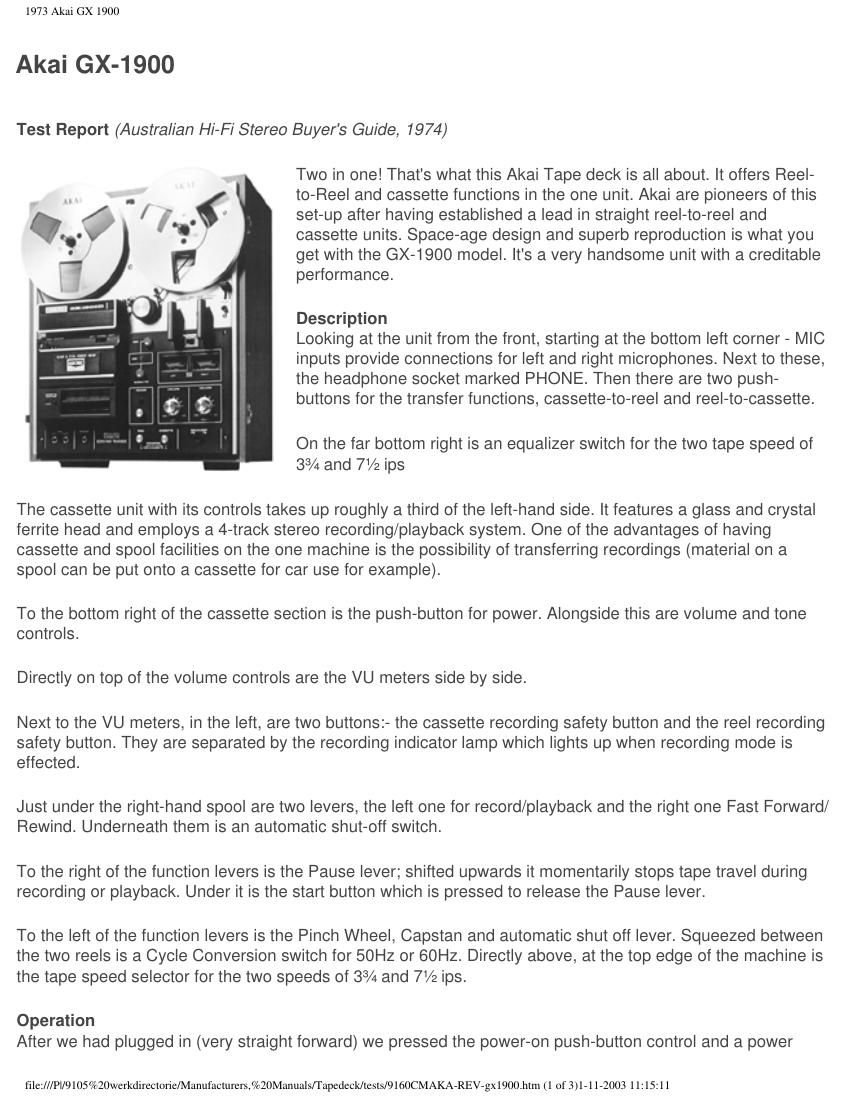Page 1
1973 Akai GX 1900
monitor lamp above the button glowed green, simultaneously the dial lamp\
s on the twin VU meters came to
life.
We popped in a pre-recorded cassette and set the transfer buttons, (as \
simple as operating the power on/off
button), in the cassette to Reel Transfer position.
Transfer of the cassette information took place smoothly and we now arri\
ved at the rather interesting position
of being able to play back either open reel or cassette, from the origin\
al cassette source.
We felt that this would give us an opportunity of examining the effect o\
f the high quality heads used in this
model. The cassette unit employs a glass and crystal ferrite head and a \
precision-made glass erase head.
The cone of this head is made of the gem crystal ferrite and is mounted \
and set in glass.
The reel unit is equipped with precision recording/playback and erase he\
ads with one shielded for high signal
to noise ratio. So we played back both cassette and reel recordings brie\
fly through the built-in monitor
speakers, before feeding the sound, firstly from the cassette unit; thro\
ugh a Leak Delta 70 Amplifier and a set
of Wharfedale speakers and finally, the sound from the open reel unit th\
rough the same system. We were
impressed with the sound from both units and considered the effect of th\
e cassette unit's glass and crystal
ferrite head in equalising between cassette and open reel performance no\
ticeably. We particularly liked the
two large front panel VU meters, which not only facilitate erasion opera\
tion but add to the attractive design of
the unit.
Internally illuminated and expanded scales provided us with a quick and \
accurate determination of recording
and playback levels. The mechanical performance of the GX-1900 Was good,\
with smooth but positive
controls over all modes of operation.
Laboratory Performance
On test the GX-1900 proved to be a competent performer in the open reel \
department. Frequency Response
(reel) was 20Hz to 20,000Hz (
1.5 dB) at 7½ ips, 20Hz to 20,000Hz ( 3 dB, at 3¾ ips. Signal to noise: 7½
ips. 52 dB (weighted) 3¾ ips. 54 dB (weighted). Cross Talk 34 dB \
T.H.D. record and playback at - 10 dB VU
7½ ips"/sec. 2.6%.
Conclusion
The GX-1900 combination unit has all the advantages of two complete reco\
rders even where space is limited.
In both open reel and cassette department the model performed competitiv\
ely but was not outstanding. The
GX-1900 is a competent performer with a lot of built-in convenience.
file:///P|/9105%20werkdirectorie/Manufacturers,%20Manuals/Tapedeck/tests\
/9160CMAKA-REV-gx1900.htm (2 of 3)1-11-2003 11:15:11

